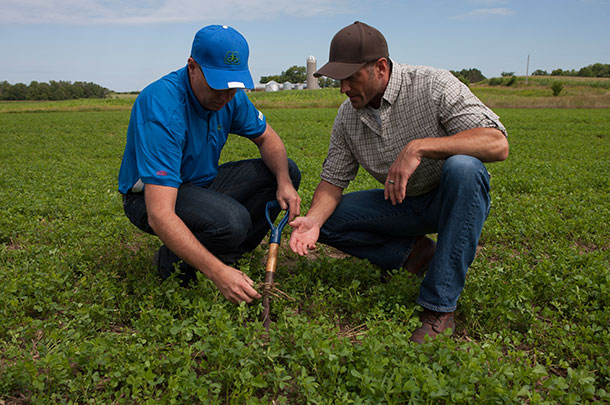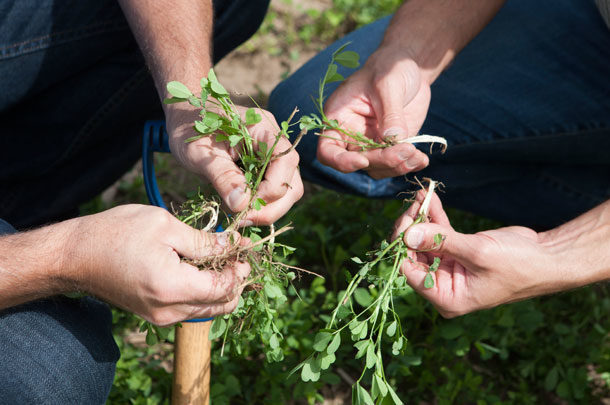Recently I asked a South Dakota alfalfa grower what he enjoyed most about growing alfalfa. His response was simple, “The best part of growing alfalfa is when I’ve finished harvesting and know I captured a high-quality crop of alfalfa.” This is every grower’s goal – to harvest and preserve high-quality alfalfa silage, starting with the first cut of the season.
One of the most important cuttings of alfalfa during the year is the first cut of spring regrowth, because it represents the largest proportion of your season’s total production of alfalfa. Also, forage quality of spring growth tends to be lower and has a high rate of decline during bud development and flowering.
Spring regrowth of alfalfa is often a slow process. In the Upper Midwest, alfalfa breaks dormancy and begins growing new shoots during late March. Assuming the plants are healthy, alfalfa will reach bud stage around mid-May. This is a growth period of 45 or more days, depending on the weather conditions.
During this relatively cool, moist growth period, alfalfa will produce a lot of dry matter, increasing total yield by an average of 100 pounds per acre per day. During late vegetative and flowering stages, leaf growth is relatively flat, and stem growth is the primary driver of increasing yield. This reduces the leaf-to-stem ratio of the plant and is largely responsible for the plant’s rapid decline in forage quality.
Quality is key
Alfalfa growers and dairymen require high-quality alfalfa forages for use with dairy animals, which makes the timing of alfalfa’s first cut critical. The ability to predict forage quality prior to harvest is in high demand. Alfalfa and alfalfa-grass stands mature more quickly and lose nutritive quality faster during the spring growth cycle than during summer or fall growth periods.
University of Wisconsin data suggests the average decline in alfalfa’s relative feed value (RFV) is four to five units per day during the late vegetative and flowering stages of growth. Even a three- or four-day delay in harvest can make the difference between high-quality and average-quality alfalfa silage. A key complication for timing alfalfa’s first cut is the range of weather and growth conditions that influence plant development and quality.
Work by Mike Rankin, extension professor at the University of Wisconsin, shows that alfalfa RFV on May 20 in Fond du Lac County, Wisconsin, ranged from a high of 280 RFV to a low of 145 RFV over a 22-year period. This annual variability points toward the need for reliable tools to predict forage quality.

Making predictions
Several tools have been developed and utilized for predicting alfalfa forage quality prior to harvest. Two of the most effective are the predictive equation for alfalfa quality (PEAQ) and scissor-clip programs.
The PEAQ system requires a user to measure plant height and evaluate the development stage (vegetative, bud, flower) of the most mature stem in an alfalfa field sample. The data is then plugged into an equation to determine RFV. To make it easy to evaluate multiple samples quickly, a PEAQ stick was developed with markings to show RFV for each stage and stem length measured.
PEAQ sticks have become widely used among alfalfa growers. One side benefit is that using the PEAQ stick requires you to be in the field, where you can observe other potential issues – such as insect or disease pressure. When lodging occurs, however, PEAQ sticks become less precise.
Another limitation is that the PEAQ system was designed to measure neutral detergent fiber (NDF) and RFV. While RFV offers a good sense of forage quality, RFQ (which factors in NDF and fiber digestibility) has become the preferred method of prediction.
Scissor-clip programs have been available in Wisconsin and Minnesota to help identify changing forage quality across both geography and time during the spring growth period of alfalfa. To increase access to this information, the University of Wisconsin publishes results on their website for scissor-clip samples taken around the state. Growers can monitor alfalfa quality changes in nearby counties or around the state to aid their own harvest timing decisions. Some local forage labs also offer this service.
Timing of harvest
A key question to ask is when should harvest begin relative to the results you get from PEAQ sticks or scissor-cut reports? One rule of thumb is to begin harvest when readings are 15 to 20 points higher than your target RFV or RFQ. If you are targeting 175 to 180 RFQ, then begin harvesting when you begin getting RFQ readings of 190 to 200.
For best results on your farm, take scissor-clip samples of your fields pre-harvest and then sample your harvested forage and compare the two. This will help you know the PEAQ reading you need to hit your target feed quality.
Weather delays and rain damage can quickly reduce forage quality and impact silage fermentation success. Delayed harvest reduces quality due to increased fiber amounts and reduced crude protein and energy density. Rainfall events may result in additional field operations to encourage drying, which lead to diminished quality from leaf shatter. Rainfall on cut alfalfa also leaches soluble sugars. Since sugars are a direct food source for lactic acid bacteria, sugar losses can impact lactic acid production and pH changes in the ensiled alfalfa silage.
Your best first-cut alfalfa crop starts with understanding the trade-offs between yield and quality. Plan for your animal and operational needs based on inventory and quality needs. Once you have a quality target set, use a predictive tool like PEAQ or scissor-clip to help hit the target. Finally, prepare your equipment and crew to harvest and ensile your alfalfa silage quickly to achieve the best fermentation possible. FG

Daniel Wiersma
Livestock Information Manager
DuPont Pioneer
PHOTOS
Evaluate the progress of your alfalfa crop with a trusted adviser to achieve optimal harvest quality. Photos provided by Dan Wiersma.












